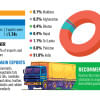The smartest ways to adapt to climate
Bangladesh is one of the most vulnerable countries in the world when it comes to climate change. Millions of citizens are already exposed to severe natural disasters like cyclones, flooding, tidal surges, heat waves, and drought, and rising sea levels are compounding the effects of the sinking Ganges River delta.
Shifts in global climate will exacerbate some extreme weather and threaten even more of the vulnerable people who live in the country's coastal regions. Moreover, it is clear that poverty is one of the biggest causes of climate vulnerability, so to help we should also consider general policies to reduce impoverishment.
New research by economists Alexander Golub and Elena Strukova Golub examines several solutions that can help tackle climate impacts over the short or long term.
Without adaptation, future climate change could have profound consequences on Bangladesh's economy. Coastal areas are most vulnerable to flooding and other climate change effects, therefore the solutions proposed focus on adaptation in these regions.
Their first solution looks at mangroves. Bangladesh could protect and replant mangroves in coastal regions, which would serve as a natural buffer to cyclones while also sequestering carbon. And mangroves offer additional benefits, including increased biodiversity, fish habitat, and ecotourism opportunities. It's very expensive, however, because it involves moving 20 million cubic metres of land each year and planting mangroves on about 40 kilometres of coastline each year. Protecting mangroves in the Sundarbans Reserved Forest would require more than Tk. 105 billion over the next 30 years. On balance, mangrove protection and reforestation would provide benefits, for climate protection as well as ecosystem services and tourism, of Tk. 2.8 per taka spent.
A second proposal is to build early warning systems and shelters where people can take refuge when a cyclone strikes. Many people do not use the current shelters because they cannot accommodate cattle and other valuable livestock, so the proposed structures would accommodate both people and livestock. They would help prevent both human deaths and injuries as well as loss of livestock. Bangladesh would need about 530 shelters in coastal regions, but they are quite expensive per storm given that the most devastating cyclones occur infrequently—with a serious cyclone every three years on average (Bangladesh Climate Change Strategy and Action Plan 2009). Each multipurpose shelter would cost about Tk. 85 million, and each taka spent would do Tk. 1.8 of good.
A third potential solution is to build polders, tracts of land surrounded by dikes that protect agriculture, housing, and infrastructure from flooding. However, the benefits depend strongly on the likelihood of flooding. If it rises above three metres - a frequent occurrence in some localities - then polders will often be breeched and provide no benefit at all. They are also extremely expensive and would cost Bangladesh more than Tk. 372 billion to build. Constructing polders where flooding would exceed three metres would cost more than the benefits provided. A better proposal is to focus on the areas where flooding is likely to be less than three metres – which is still enough to kill and destroy. Because lower polders are cheaper and because they won't fail as much, they will do more good: Tk. 1.8 of climate benefits for each taka spent.
These solutions help with specific problems that have specific solutions. A more all-encompassing solution would focus on making Bangladesh a wealthier country so that her people can tackle climate shocks better. It is well known that a more developed economy is better suited to cope with many challenges, including adaption to climate change. The authors examine two long-term solutions that broadly aim to boost economic growth, diversify the economy, and increase human capital formation.
Indeed, the authors' study is part of the larger Bangladesh Priorities project, which looks at many other solutions that can help make Bangladesh a stronger and more prosperous society.
The first of the more general climate proposals aims to increase productivity of labour employed in agriculture through investment in capital and training. The cost would be just over Tk. 700,000 per worker over the next two decades and could increase agricultural productivity by 10 percent. In all, each taka spent could provide a return of Tk. 3.7 over 20 years.
Another option is to move workers from agriculture into more productive jobs by relocating them to second-tier manufacturing cities. Over the next decade, 1 million people, who live in areas unprotected by mangroves, could be relocated, reducing damage from cyclones. This alone would do just over Tk. 1 of good for each taka spent. But moving them to manufacturing cities and providing them with training creates potential for the type of productivity growth necessary to improve resilience to climate change, while improving life quality for the individuals.
It would require investment between Tk. 439,000 and Tk. 1.3 million per person trained and relocated. But by increasing productivity and removing people from dangerous coastal zones, you would do Tk. 2.6 of good for each taka spent.
Climate change presents many challenges, but there are promising strategies to help Bangladesh cope. With scarce resources, is this where you would start, and which of these many solutions would you focus on first? Let us hear from you at https://copenhagen.fbapp.io/climatepriorities. We want to continue the conversation about how Bangladesh can do the most good for every taka spent.
The writer is president of the Copenhagen Consensus Center, ranking the smartest solutions to the world's biggest problems by cost-benefit. He was named one of the world's 100 most influential people by Time magazine.

 For all latest news, follow The Daily Star's Google News channel.
For all latest news, follow The Daily Star's Google News channel. 








Comments